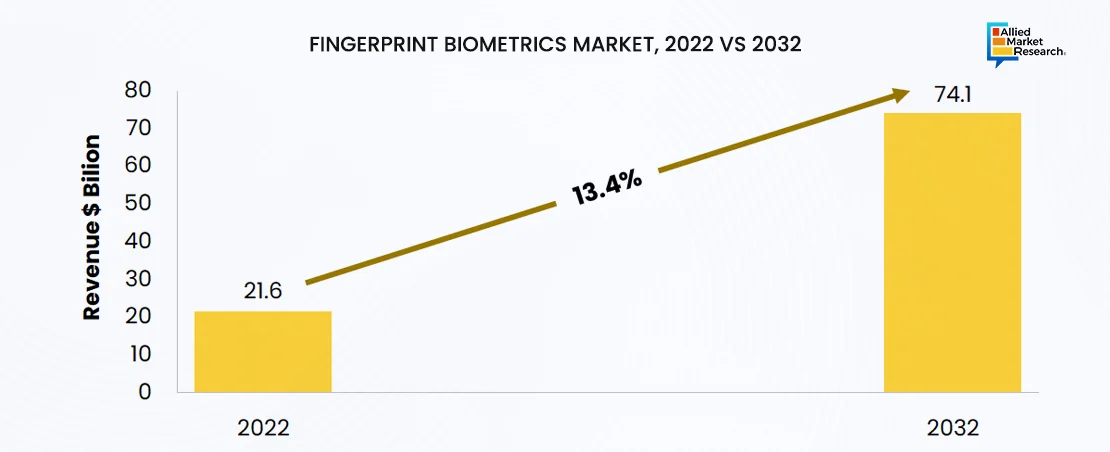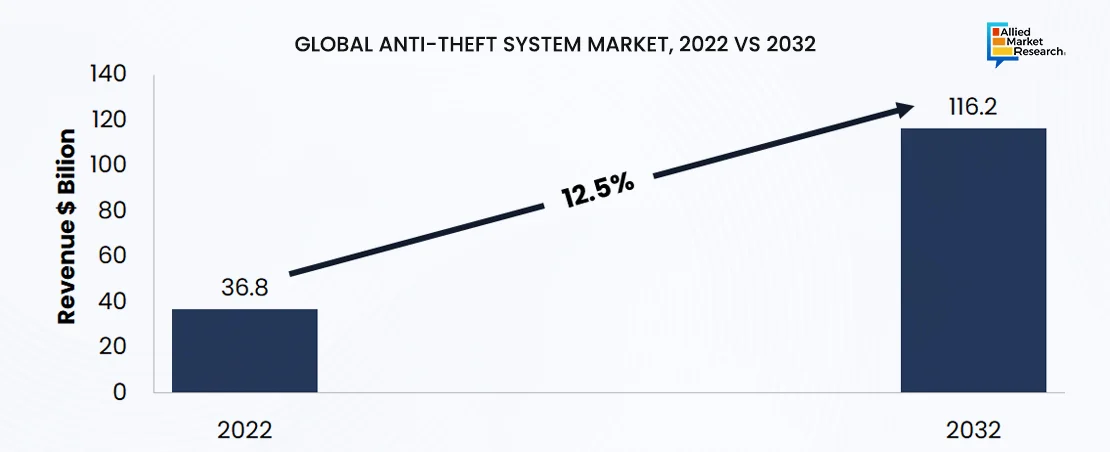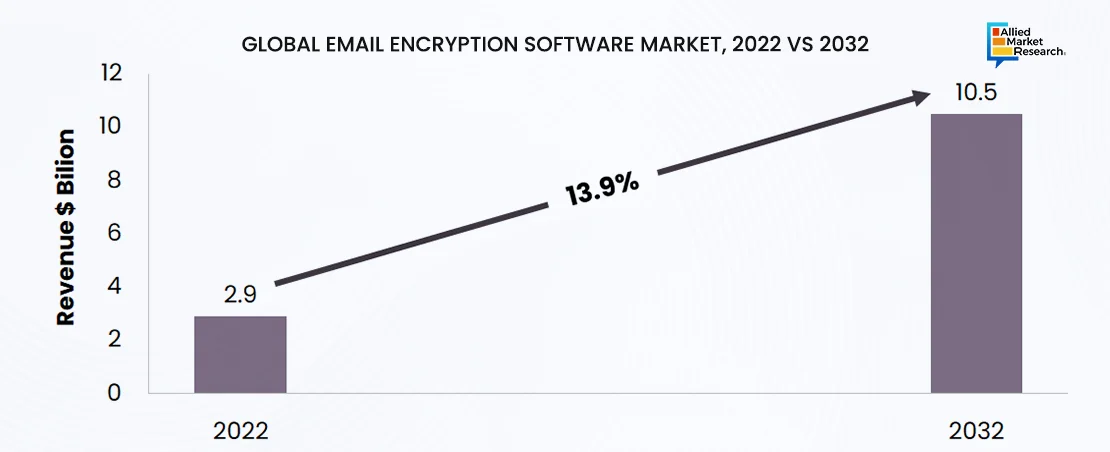Table Of Contents

Onkar Sumant

Pooja Parvatkar
ICT Sector's Top 5 Emerging Markets in Q1 2024: Allied Market Research's Comprehensive Analysis

Leveraging AMR's 'Title Matrix Tool', research analysts have meticulously assessed these markets based on various parameters. These parameters include relevance, growth potential, technological innovation, customer demand trends, competitive landscape, and regulatory environment.
The reports on these top 5 markets aim to address critical industry queries, such as current size and projections, growth catalysts, strategies adopted by major players, potential risks, regional dynamics, and competitive positioning. Additionally, they integrate historical data and retrospective analysis to provide a comprehensive view of trends and trajectories.
Outlined below are the top 5 emerging markets driving innovation, meeting technological demands, and shaping the future of the ICT sector.
1. Fingerprint Biometrics
The fingerprint biometrics market stands out driven by its unparalleled security and reliability in identity verification, particularly in critical sectors like finance, healthcare, and government. As technological advancements continue to improve accuracy and speed, fingerprint biometrics are being embraced across a wide range of applications, from smartphone authentication to border control. Moreover, escalating cybersecurity concerns and the quest for resilient authentication solutions are fueling the surge in demand for fingerprint biometrics. The fingerprint biometrics market is projected to continue its robust growth trajectory, with a forecasted value of $74.1 billion by 2032. The market is strategically important to research right now due to its pivotal role in addressing escalating cybersecurity threats and the increasing demand for robust authentication solutions across critical sectors.
The report offers a comprehensive overview of Porter’s five forces analysis of the fingerprint biometrics market. The bargaining power of suppliers is moderated by the presence of multiple hardware and software providers, ensuring competitive pricing and innovation. Competitive intensity is high, driven by the presence of major players like Thales and NEC Corporation, fostering innovation and product differentiation. The threat of new entrants remains moderate due to high initial capital requirements and stringent regulatory compliance. However, the threat of substitutes is relatively low, owing to the several advantages of fingerprint biometrics in security and authentication. Leveraging this analysis, stakeholders can understand the competitive landscape and assess the market's potential.

2. Anti-Theft System
The global anti-theft system market is poised to expand significantly, projected to grow 3.15 times by 2032 compared to its 2022 size. The market is projected to reach $116.2 billion by 2032, growing at a CAGR of 12.5% from 2023 to 2032. This growth is attributed to the increasing incidents of vehicle and property theft worldwide, which have raised awareness among consumers, businesses, and governments regarding the importance of robust security measures. Consequently, there is a rising demand for anti-theft systems to safeguard valuable assets and mitigate theft-related risks. Furthermore, the integration of anti-theft features into smart home and vehicle technologies is driving growth. The market is strategically important to research right now due to its significant projected growth, driven by escalating security concerns and the integration of anti-theft features into smart technologies, presenting lucrative opportunities for stakeholders.
The report provides a detailed segmentation analysis of the anti-theft system market, categorizing it by components (hardware, software, services), product types (biometric capture devices, remote keyless entry, alarms), industry verticals (automotive, BFSI, retail), and regions (North America, Europe, Asia-Pacific, LAMEA). The biometric capture devices segment led the market due to their reliability in identifying individuals through unique biological traits like fingerprints or facial recognition. The remote keyless entry systems segment is also prominent, offering convenient and secure access to vehicles and buildings. The alarms segment is experiencing rapid growth driven by advancements in technology and increasing security concerns. In terms of industry verticals, the automotive segment leads the market growth, mainly due to the increase in vehicle thefts and governmental initiatives to curb such crimes. In terms of regional performance, Asia-Pacific demonstrated the most significant growth in 2022 and is projected to maintain its position as the fastest-growing segment.

3. Email Encryption Software
The email encryption software market is poised for significant expansion, driven by the rapid growth of cloud-based email platforms such as Office 365 and Gmail. This surge emphasizes the critical need for encryption to ensure the security of data transmitted and stored across these channels. Moreover, the seamless integration with cloud-based email services continues to drive growth. Additionally, the proliferation of remote and mobile work practices has amplified email communication via mobile devices. With mobile-friendly solutions, email encryption software facilitates secure email access and transmission from smartphones and tablets, fostering robust growth throughout the forecast period. The global email encryption software market is projected to reach $10.5 billion by 2032. The market is strategically important to research right now due to the escalating demand for email encryption software amid increasing cybersecurity threats and the growing adoption of cloud-based email services.
The report offers a comprehensive overview of the PESTLE analysis, examining the macro-environmental factors influencing the email encryption software market. Political factors such as government regulations and data protection laws shape the landscape for top players, while economic factors like global economic stability and currency fluctuations impact investment decisions. Social trends, including the rise of remote work and mobile communication, drive the demand for secure email solutions. Technological advancements in encryption algorithms and cloud computing present opportunities for market growth. Legal considerations such as compliance with privacy laws and intellectual property rights also affect market dynamics.

4. Storage Area Network (SAN)
The global storage area network (SAN) market is projected to expand substantially, reaching $52.3 billion by 2032, reflecting a robust CAGR of 10.7% from 2023 to 2032. As server virtualization and cloud computing become more prevalent, there is a growing need for adaptable and scalable storage solutions to handle dynamic workloads. Storage Area Networks (SANs) serve as centralized storage hubs, facilitating resource sharing across numerous virtualized servers, thus optimizing resource allocation and workload distribution. Additionally, the ever-increasing volume of digital data generated by businesses and individuals calls for scalable and efficient storage solutions. SANs, with their high-performance infrastructure, are well-equipped to manage large datasets effectively, further fueling the demand. The market is strategically important to research right now due to its pivotal role in providing scalable and efficient storage solutions amid the rapid growth of digital data and the increasing adoption of server virtualization and cloud computing.
The report offers a comprehensive SWOT analysis, highlighting strengths, weaknesses, opportunities, and threats. Strengths include the market's ability to provide centralized storage solutions amid the growing demand for scalable storage infrastructure. Weaknesses may involve challenges such as cost constraints and legacy system integration. Opportunities lie in the surge of digital data and the adoption of cloud computing, driving demand for storage solutions. However, threats may arise from competition and compatibility issues with emerging technologies.
5. Online Microtransaction Market
The global online microtransaction market is projected to hit $219.4 billion by 2032, growing at a CAGR of 13.2% from 2023 to 2032. The surge in digital payment methods and the ubiquitous presence of online shopping platforms have ignited a surge in microtransactions. Consumers now embrace the idea of making frequent, small payments for digital content, in-app upgrades, and virtual merchandise, propelling growth. Additionally, the escalating demand for digital entertainment like music, video streaming, gaming, and e-books has opened a profitable avenue for microtransactions. With consumers showing willingness to spend on premium content, extra features, or virtual assets within digital ecosystems, the market continues to flourish. The market is strategically important to research right now due to its substantial growth potential and its pivotal role in shaping digital commerce trends.
The report offers a comprehensive overview of regional analysis, shedding light on the geographical dynamics influencing the online microtransaction market landscape. With North America leading in revenue generation in 2022, propelled by diverse microtransaction offerings spanning social media platforms, digital marketplaces, and various online services, the region demonstrates a robust adoption of microtransactions. Meanwhile, Asia-Pacific is poised to exhibit significant growth during the forecast period, fueled by increasing internet penetration and accelerated digitalization initiatives.
The Bottom Line
With technological advancements and changing consumer preferences driving rapid evolution in the ICT industry, it is crucial for companies to adapt their strategies accordingly. For market players and stakeholders in the ICT industry, the insights provided in the extensive reports are essential for crafting effective strategies and seizing lucrative opportunities in these burgeoning markets. Leveraging AMR's meticulous research methodology and in-depth analysis, stakeholders can gain a competitive edge and capitalize on emerging trends. To explore further and delve deeper into these emerging markets, contact AMR analysts for tailored insights and strategic guidance.

